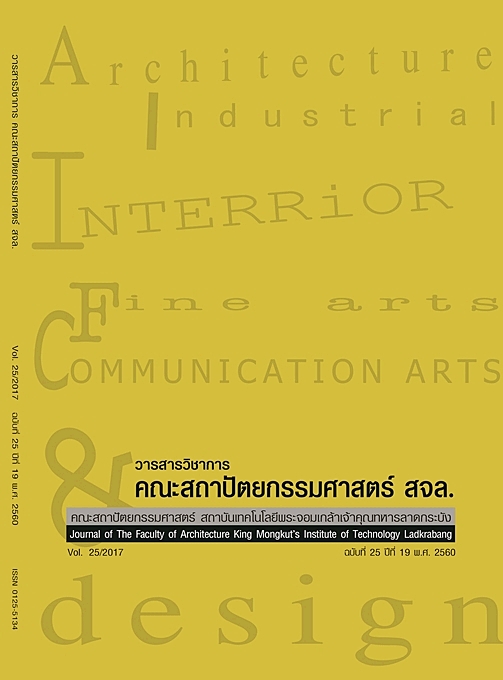คุณลักษณะของสีต่ออารมณ์และการตัดสินใจเข้าร้านอาหารไทยและญี่ปุ่น (Color Attributes on Emotion and Entering Decision of Thai and Japanese Restaurant)
Main Article Content
Abstract
บทคัดย่อ
ร้านอาหารเป็นหนึ่งในบรรดาธุรกิจที่มีการเติบโตและแข่งขันกันสูง สีเป็นเทคนิคสำคัญในการออกแบบให้ดึงดูดใจลูกค้าและเพิ่มโอกาสด้านการตลาด การศึกษาวิจัยนี้มุ่งศึกษาอิทธิพลของกลุ่มสีต่ออารมณ์ 3 ลักษณะ ได้แก่ ความพึงพอใจความตื่นตัวและความโดดเด่น และการตัดสินใจเข้าร้านในบริบทของร้านอาหารไทยและญี่ปุ่น จากผู้เข้าร่วมทดสอบ 66 คน แต่ละคนได้ประเมินภาพจำลองร้านอาหารด้วยโปรแกรมคอมพิวเตอร์ 8 ภาพ ที่วรรณะของสีและความสดของสีแตกต่างกัน โดยให้คะแนนระดับอารมณ์ด้วยคำแสดงอารมณ์ 6 คู่คำ และระบุการตัดสินใจเข้าร้าน การวิเคราะห์ผลด้วยวิธี t-test เพื่อเปรียบเทียบระหว่างสีวรรณะร้อนและเย็น และสีที่มีความสดสูงและต่ำ พบว่าคุณลักษณะของสีทั้งสองส่งผลต่ออารมณ์อย่างมีนัยสำคัญ (p<.05) กลุ่มสีวรรณะร้อนที่มีความสดต่ำสร้างอารมณ์เชิงบวกในร้านอาหารได้สูงกว่ากลุ่มสีอื่น อีกทั้งรูปแบบ
การตกแต่งร้านยังส่งผลต่ออารมณ์ (p<.05) และมีปฏิสัมพันธ์ต่อการรับรู้สี สีวรรณะร้อนที่มีความสดสูงสร้างอารมณ์เชิงบวกในภาพร้านอาหารไทย ส่วนสีที่มีความสดต่ำสร้างอารมณ์เชิงบวกในร้านอาหารญี่ปุ่น การพยากรณ์โอกาสในการตัดสินใจเข้าร้านและความสัมพันธ์ระหว่างตัวแปรต่อการตัดสินใจ ได้มีการวิเคราะห์ความถดถอยโลจิสติค ซึ่งความรู้สึกชื่นชอบ ความสบายและการดูมีราคา เป็นตัวแปรด้านอารมณ์ที่เหมาะสมในการพยากรณ์โอกาสในการตัดสินใจเข้าร้าน งานวิจัยนี้สรุปได้ว่าวรรณะของสีและความสดของสีเป็นปัจจัยสำคัญในการออกแบบ ที่สร้างอารมณ์เชิงบวกต่อสภาพแวดล้อมของร้านและการเข้าร้านผู้ออกแบบจึงควรเลือกใช้สีที่ให้ความรู้สึกชื่นชอบ น่าสบายและดูหรูหรามีราคา เพื่อให้เข้าใจอิทธิพลของสีต่อการตอบสนองด้านอารมณ์ของลูกค้าและการตัดสินใจเข้าร้านมากยิ่งขึ้น ควรศึกษาคุณลักษณะอื่นของสีและบริบทของสภาพแวดล้อมจริง
เพิ่มเติม
คำสำคัญ: วรรณะของสี ความสดของสี อารมณ์ การตัดสินใจเข้า ร้านอาหาร
Abstract
Restaurant is one of many growing and highly competitive business. Color is an important technique in design to attract customers and increase market opportunities. This study aims to examine the effects of
color combinations on three emotional characteristics: pleasure, arousal and dominance, and decision-making in Thai and Japanese restaurant contexts. Sixty six research participants in this study in which each participant
evaluated eight computer - generated restaurant scenes which were different color tones and color saturation.They evaluated his/her emotional responses on six adjective word pairs and specified his/her restaurant entry
decision. The data were analyzed by t-test for comparison between warm and cool color tone including high and low saturation. The result showed that the both color attributes significantly all emotional characteristics
(p<.05). Low saturated - warm tone colors induced more positive emotional responses compared to other types of colors. Restaurant decoration was also influenced to emotion (p<.05) and related to color recognition. Warm
tones with high saturated colors built up a positive emotion to the scene of Thai restaurant, while warm tones with low saturated colors were positive for Japanese restaurant. Logistic regression analysis for entering decision
showed that ‘pleasant’, ‘comfortable’ and ‘expensive image’ restaurant images were good predictors in restaurant entering prediction. This study concluded that color tones and color saturation are important design factors to
create positive environment and customers’ emotions for entering the restaurant. Designers should select colors which induce the feeling of pleasure, comfortable, and expensive luxurious images. To fully understand the
effect of colors on customer’s responses for more entering decision, additional color attributes and context of actual environment should be further examined.
Keywords: Color Tone, Color Saturation, Emotion, Entry Decision, Restaurant
Article Details
This work is licensed under a Creative Commons Attribution-NonCommercial-ShareAlike 4.0 International License.
Copyright Transfer Statement
The copyright of this article is transferred to Journal of The Faculty of Architecture King Mongkut's Institute of Technology Ladkrabang with effect if and when the article is accepted for publication. The copyright transfer covers the exclusive right to reproduce and distribute the article, including reprints, translations, photographic reproductions, electronic form (offline, online) or any other reproductions of similar nature.
The author warrants that this contribution is original and that he/she has full power to make this grant. The author signs for and accepts responsibility for releasing this material on behalf of any and all co-authors.

